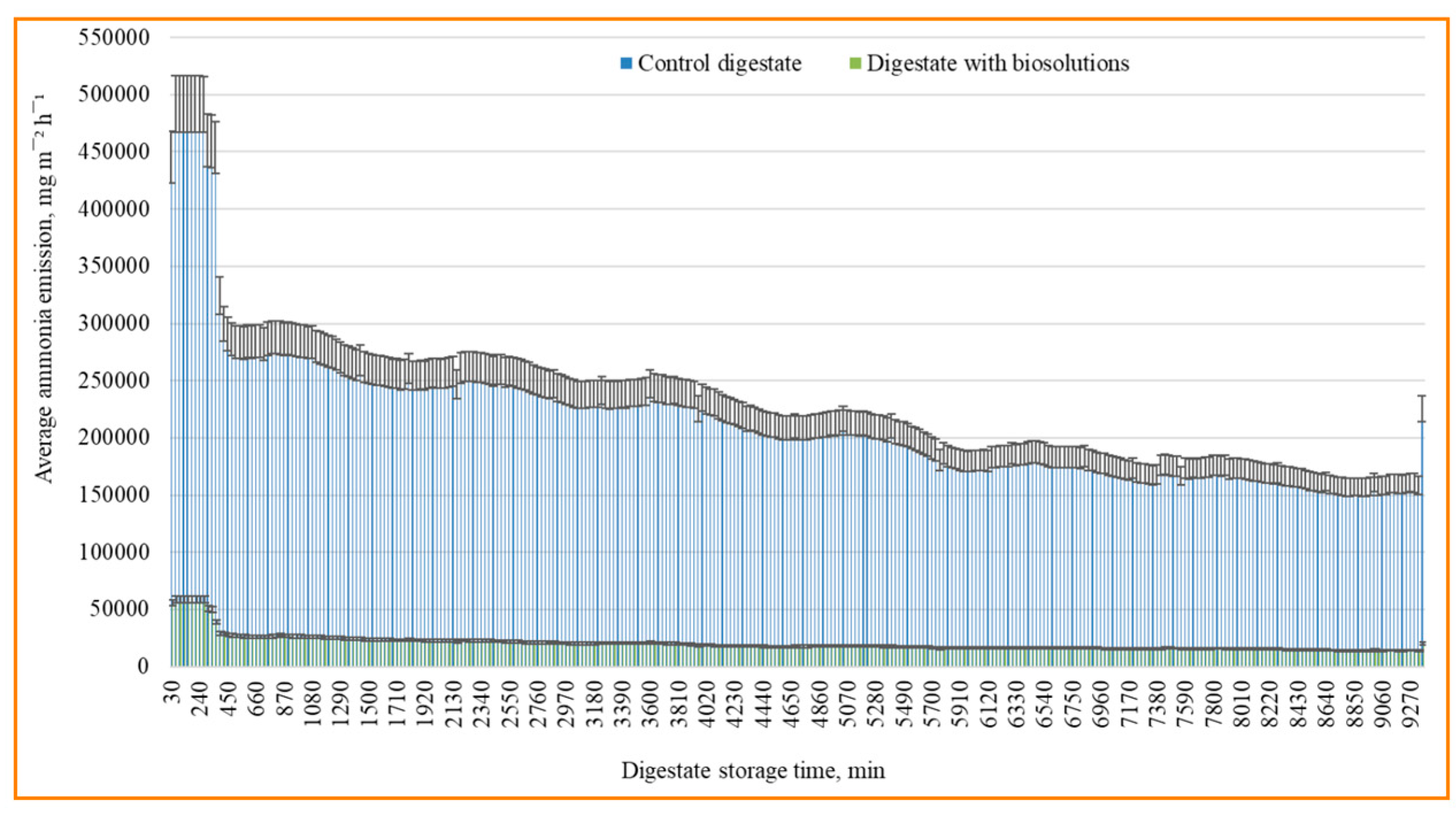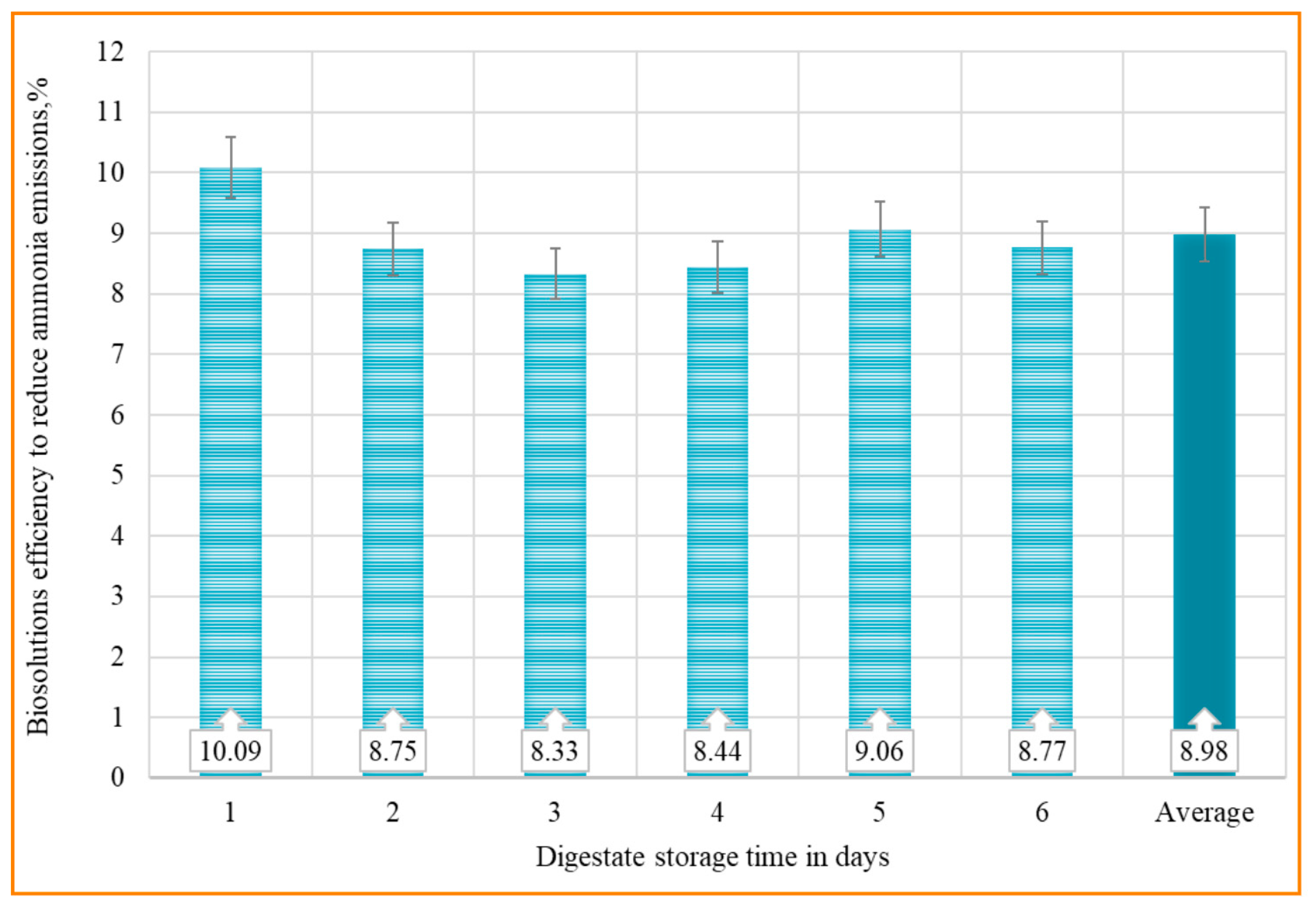1. Introduction
Digestate (anaerobic ferment) is an organic substance remaining after the anaerobic processing (fermentation) of organic matter or biodegradable waste—biogas extraction or anaerobic alcoholic fermentation— or bioethanol extraction. Biogas production waste digestate is a valuable fertilizer in agriculture, but there are issues with odor emissions and it contributes to pollution without comprehensive management strategies. Raw materials, processing technology and process operating conditions greatly influence the characteristics of the digestate product [
1]. To date, no data are available on digestate production, but according to EU-28 estimates, around 180 million tons of digestate are produced annually, of which 68% are of agricultural origin [
2]. Cascade pre-treatment with ozonation and ammonia removal is applied for sustainable liquid digestate treatment, nutrient recovery and value-added biomass production [
3].
2. Method
In order to reduce environmental air pollution, the efficiency of integrating a homogenized biosolution—an activator of rotting residues into the digestate for ammonia emission—was evaluated via scientific studies of ammonia gas emission. The purpose of the study was to evaluate the effect of a homogenized biosolution in the digestate on reducing ammonia emissions. The biosolution was a rotting residue activator (carrier molasses without GMO, calcium carbonate, dolomite, sodium hydrogen carbonate, and magnesium sulphate), complied with EC Eco-BasisVO 834/2007 and 889/2008, had ECOCERT approval, was listed in FiBL Switzerland, and manufactured by Roland with Plocher integral technology; the physical and chemical structure of molasses do not change after processing. It is recommended to add 1.5–2 L/100 m3 of the biosolution to the liquid part of the digestate. The assessment of ammonia gas emission was performed by measuring the average ammonia concentration values fixed in time intervals every 15 min via the automatic switching of the analyzer channels, in order to first assess the sudden immediate effect of the biosolution and the regular gradual long-term effect.
The consistent structure of the digestate observed via surface visualization showed an increased density and percentage composition of dry matter in the digestate with biosolutions. The differences in ammonia emissions from the control and digestate with additives after certain test periods confirm the previously obtained results and show the effect and target efficiency of biosolutions in the processes taking place in manure (
Figure 1).
3. Results and Discussion
After evaluating the average emission of ammonia gas from the control and digestate with biosolutions depending on the duration of digestate storage, the correlation of the values compared with each other was established and the effect of the allocation of the biosolution—the rotting residue activator in the digestate—on the reduction of ammonia concentration and emission was recorded (
Figure 2,
Figure 3 and
Figure 4).
The highest efficiency of the biosolution in reducing ammonia emissions ranged from 3 to 43% in the period from 1 to 100 h, which reached up to 450,000 mg m
−2h
−1. After evaluating the overall average reduction in ammonia emissions from the digestate with a biosolution over the entire period, the essential effect of the use of biosolutions was proven and the highest effect was recorded in the first 24 h after the allocation of the biosolution—the activator of rotting residues in the digestate (
Figure 2).
After evaluating the average concentration and emission of ammonia gas from the control and digestate with biosolutions depending on the duration of digestate storage, the correlation of the values compared with each other was established and the effect of the allocation of the biosolution—the rotting residue activator in the digestate—on reducing ammonia concentration and emission was recorded (
Figure 3).
After identifying the variation in the change in ammonia emission after affecting the digestate with a biosolution, the essential efficiency of the biosolution in reducing ammonia emission in the first days of storage was found to be 8.98% on average. The greatest reduction in ammonia emissions of up to 10.09% using biosolutions was determined on the first day, justifying the immediate effect and maximum efficiency of the biosolution at the beginning of the experimental studies. When evaluating the regular long-term effect of the biosolution on reducing ammonia emissions from the digestate, it varied on average from 8.33 to 10.09% (
Figure 4).
Other scientific analyses have found that as the size of anaerobic digesters (AD) continues to increase, the handling and disposal of digestate becomes a challenging task for AD operators. Anaerobic digestate contains many nutrients and pollutants; thus, appropriate treatment is required to comply with environmental legislation and protect the host environment. The use of digestate helps to recycle already extracted resources. Efforts have been made to use digestate as a raw material for energy and value-added products, which can certainly help create a circular economy in modern society. This could help decision-makers to pre-determine environmentally sound and sustainable solutions [
4]. Scientists describing trials of different digestates with different plants demonstrate high efficiency determined by an increase in yield (up to 28%), nitrogen uptake (20%) or phosphorus recovery rate (43%), or an increase in biometric parameters (such as leaf area) [
5].
The use of digestate in agriculture is an effective way to recycle materials and reduce the use of mineral fertilizers. Agronomic properties of digestates can improve plant growth and soil properties after digestate fertilization. In one study, all urban digestates tested produced 5–30% higher ryegrass yields compared to control mineral fertilizers with similar inorganic nitrogen concentrations, and the source of the feedstock affected the agronomic value [
6].
Thus, supplementing the digestate with various nutrients and specialized biosolutions provides an even better fertilizing value and even better prospects for reducing odor emissions.
4. Conclusions
After identifying the variation in the change in ammonia emissions after affecting the digestate with the biosolution, the significant efficiency of the biosolution in reducing the ammonia emission in the first days of storage was determined to be on average from 8.33 to 10.09%.
The highest effectiveness of the bio additive in the first 24 h explained the desired immediate effect and maximum efficiency observed immediately after the allocation of the rotting residue activator in the digestate.
Author Contributions
Conceptualization, V.N. and E.S.; methodology, V.N.; software, E.S.; validation, V.N. and E.Š.; formal analysis, E.Š.; investigation, V.N. and E.S.; data curation, V.N.; writing—original draft preparation, V.N.; writing—review and editing, E.Š.; visualization, V.N.; supervision, V.N. All authors have read and agreed to the published version of the manuscript.
Funding
This research received no external funding.
Institutional Review Board Statement
Not applicable.
Informed Consent Statement
Not applicable.
Data Availability Statement
The data requested by contacting the corresponding author.
Conflicts of Interest
The authors declare no conflict of interest.
References
- Lamolinara, B.; Pérez-Martínez, A.; Guardado-Yordi, E.; Fiallos, C.G.; Diéguez-Santana, K.; Ruiz-Mercado, G.J. Anaerobic digestate management, environmental impacts, and techno-economic challenges. Waste Manag. 2022, 140, 14–30. [Google Scholar] [CrossRef] [PubMed]
- Catenacci, A.; Boniardi, G.; Mainardis, M.; Gievers, F.; Farru, G.; Asunis, F.; Malpei, F.; Goi, D.; Cappai, G.; Canziani, R. Processes, applications and legislative framework for carbonized anaerobic digestate: Opportunities and bottlenecks. A critical review. Energy Convers. Manag. 2022, 263, 115691. [Google Scholar] [CrossRef]
- Zhu, S.; Jiang, R.; Qin, L.; Huang, D.; Yao, C.; Xu, J.; Wang, Z. Integrated strategies for robust growth of Chlorella vulgaris on undiluted dairy farm liquid digestate and pollutant removal. Sci. Total Environ. 2022, 852, 158518. [Google Scholar] [CrossRef] [PubMed]
- Malhotra, M.; Aboudi, K.; Pisharody, L.; Singh, A.; Banu, J.R.; Bhatia, S.K.; Varjani, S.; Kumar, S.; González-Fernández, C.; Kumar, S.; et al. Biorefinery of anaerobic digestate in a circular bioeconomy: Opportunities, challenges and perspectives. Renew. Sustain. Energy Rev. 2022, 166, 112642. [Google Scholar] [CrossRef]
- Samoraj, M.; Mironiuk, M.; Izydorczyk, G.; Witek-Krowiak, A.; Szopa, D.; Moustakas, K.; Chojnacka, K. The challenges and perspectives for anaerobic digestion of animal waste and fertilizer application of the digestate. Chemosphere 2022, 295, 133799. [Google Scholar] [CrossRef] [PubMed]
- Angouria-Tsorochidou, E.; Seghetta, M.; Trémier, A.; Thomsen, M. Life cycle assessment of digestate post-treatment and utilization. Sci. Total Environ. 2022, 815, 152764. [Google Scholar] [CrossRef] [PubMed]
| Disclaimer/Publisher’s Note: The statements, opinions and data contained in all publications are solely those of the individual author(s) and contributor(s) and not of MDPI and/or the editor(s). MDPI and/or the editor(s) disclaim responsibility for any injury to people or property resulting from any ideas, methods, instructions or products referred to in the content. |
© 2023 by the authors. Licensee MDPI, Basel, Switzerland. This article is an open access article distributed under the terms and conditions of the Creative Commons Attribution (CC BY) license (https://creativecommons.org/licenses/by/4.0/).










